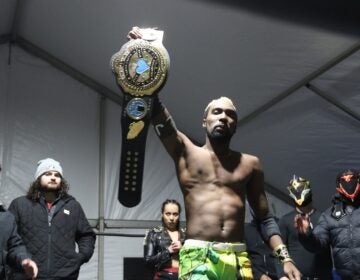COVID-19 laid bare inequities in our city’s creative economy. Here’s how Philly can fix it
Michael Forman, co-founder of the Forman Arts Initiative, argues a new local infrastructure must be built to support and include neighborhood-based artists and orgs.

A view of the Philadelphia skyline from the 52nd Street station on the Market-Frankford elevated line in West Philadelphia. (Emma Lee/WHYY)
After more than a year of dark theaters, shuttered museums and galleries, and silent concert halls, Philadelphia’s creative community has reached a dangerous tipping point: Just as the pandemic has laid bare the inequity present in our city’s economy, so, too, has it exposed the haves and have-nots in our arts community.
No institution is ever prepared to weather more than a year with little to no revenue or audience. But our city’s most established institutions and artists have generally had the resources to survive and adapt. On the other hand, neighborhood-based artists and institutions have suffered disproportionately as they often must compete for extremely limited resources.
Philadelphia’s more conventional cultural center of gravity skews whiter and wealthier, while the neighborhood-based individuals and organizations better reflect the city’s diversity, encompassing a large population of BIPOC artists. Because of the inequity of the current landscape, these artists have been among the hardest hit in an industry already devastated by the pandemic.
The arts form the fabric of our society and play a critical role in serving our communities. They have the power to hold a mirror up to humanity, to challenge and to uplift. And they act as a door through which important conversations emerge. In their absence this past year, Philadelphia has lost one of its strongest points of connection. But as we begin to emerge from the isolation of the pandemic and chart a course forward, we have the opportunity to rebuild our creative economy with an eye toward equity and inclusion.
To do this, we must bring resources to the arts and art to our communities by directing support to individual artists and small- to medium-sized organizations in underserved areas of our city. These neighborhood-based groups bring vitality and inspiration to Philadelphia’s streets, and artists who work outside the conventional art world have a vital role to play in our city’s creative expression.
We must pave the way for diverse artists and organizations serving our communities to share their talent. These artists and organizations have some of the most important stories to tell, and yet many do not receive recognition beyond their own communities. While Philadelphia has many exceptional arts organizations and institutions, so often their work is done in silos.
Collectively, we need to build better local infrastructure that allows artists, organizations and audiences to connect with each other across the city and across communities. Only then can we create opportunities to engage, learn, and work collectively toward common goals.
And perhaps most importantly, from the public sector to private philanthropy, we must pledge a new kind of financial support and advocacy for the arts to develop this infrastructure. In recent months, we have seen some positive steps, including new recovery dollars for the arts from City Council and money for shuttered performance venues in federal relief efforts. But this is just the beginning of what’s needed.
The arts and culture sector has a significant impact — both civic and economic — across the city and in our neighborhoods and communities. As such, government organizations, the business community, and individuals should have a vested interest and must play an active role in supporting our creative economy and, importantly, fostering equity and inclusion within it.
Experiencing art and culture is most often a collective experience, with our own reactions enhanced by those of others around us. If we can also act collectively to support equity and inclusion in our arts community and a robust recovery in our creative economy, we will ensure that this essential piece of our society can thrive for generations to come.
Michael Forman recently co-founded the Forman Arts Initiative with Jennifer Rice. FAI is a new platform to connect and support artists and cultural organizations in Philadelphia. In partnership with the Philadelphia Foundation, FAI has launched a $3 million grant program, Art Works, to provide grants to community-based arts and cultural organizations and emerging artists in Philadelphia. More information about Art Works grants can be found at https://formanartsinitiative.org/initiatives/.
 WHYY is one of over 20 news organizations producing Broke in Philly, a collaborative reporting project on solutions to poverty and the city’s push towards economic justice. Follow us at @BrokeInPhilly.
WHYY is one of over 20 news organizations producing Broke in Philly, a collaborative reporting project on solutions to poverty and the city’s push towards economic justice. Follow us at @BrokeInPhilly.
WHYY is your source for fact-based, in-depth journalism and information. As a nonprofit organization, we rely on financial support from readers like you. Please give today.


![CoronavirusPandemic_1024x512[1]](https://whyy.org/wp-content/uploads/2020/03/CoronavirusPandemic_1024x5121-300x150.jpg)


